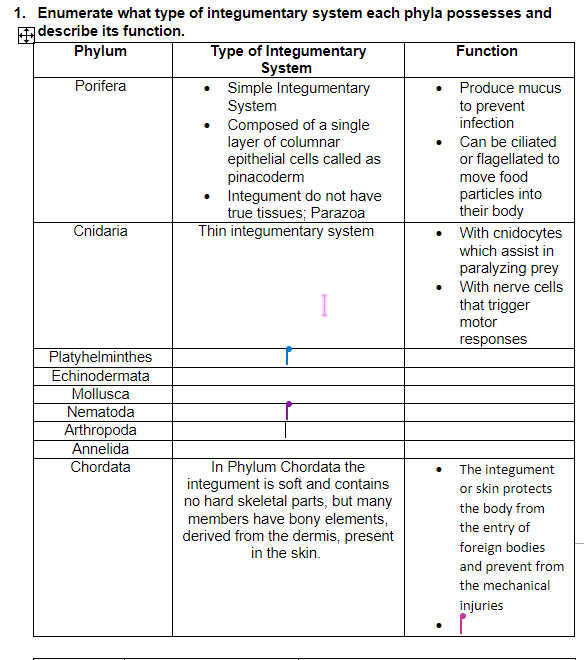Biology 2e
2nd Edition
ISBN:9781947172517
Author:Matthew Douglas, Jung Choi, Mary Ann Clark
Publisher:Matthew Douglas, Jung Choi, Mary Ann Clark
Chapter28: Invertebrates
Section: Chapter Questions
Problem 6RQ: Most sponge body plans are slight variations on a simple tube-within-a-tube design. Which of the...
Related questions
Question

Transcribed Image Text:1. Enumerate what type of integumentary system each phyla possesses and
describe its function.
Phylum
Function
Type of Integumentary
System
• Simple Integumentary
System
Composed of a single
layer of columnar
epithelial cells called as
pinacoderm
Integument do not have
true tissues; Parazoa
Thin integumentary system
Porifera
Produce mucus
to prevent
infection
• Can be ciliated
or flagellated to
move food
particles into
their body
With cnidocytes
which assist in
paralyzing prey
• With nerve cells
that trigger
Cnidaria
motor
responses
Platyhelminthes
Echinodermata
Mollusca
Nematoda
Arthropoda
Annelida
Chordata
In Phylum Chordata the
integument is soft and contains
no hard skeletal parts, but many
members have bony elements,
derived from the dermis, present
in the skin.
The integument
or skin protects
the body from
the entry of
foreign bodies
and prevent from
the mechanical
injuries
Expert Solution
This question has been solved!
Explore an expertly crafted, step-by-step solution for a thorough understanding of key concepts.
Step by step
Solved in 2 steps

Knowledge Booster
Learn more about
Need a deep-dive on the concept behind this application? Look no further. Learn more about this topic, biology and related others by exploring similar questions and additional content below.Recommended textbooks for you

Biology 2e
Biology
ISBN:
9781947172517
Author:
Matthew Douglas, Jung Choi, Mary Ann Clark
Publisher:
OpenStax

Biology: The Dynamic Science (MindTap Course List)
Biology
ISBN:
9781305389892
Author:
Peter J. Russell, Paul E. Hertz, Beverly McMillan
Publisher:
Cengage Learning

Biology Today and Tomorrow without Physiology (Mi…
Biology
ISBN:
9781305117396
Author:
Cecie Starr, Christine Evers, Lisa Starr
Publisher:
Cengage Learning

Biology 2e
Biology
ISBN:
9781947172517
Author:
Matthew Douglas, Jung Choi, Mary Ann Clark
Publisher:
OpenStax

Biology: The Dynamic Science (MindTap Course List)
Biology
ISBN:
9781305389892
Author:
Peter J. Russell, Paul E. Hertz, Beverly McMillan
Publisher:
Cengage Learning

Biology Today and Tomorrow without Physiology (Mi…
Biology
ISBN:
9781305117396
Author:
Cecie Starr, Christine Evers, Lisa Starr
Publisher:
Cengage Learning